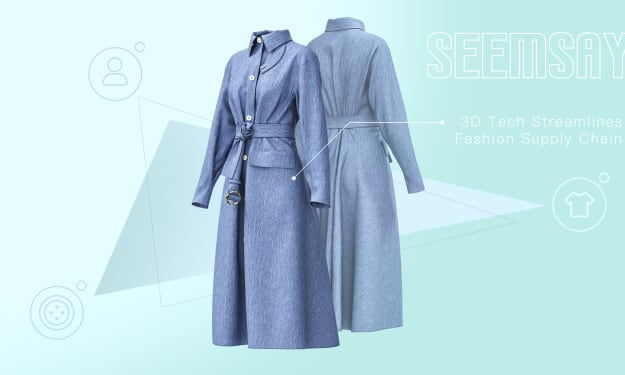
The fashion, apparel and luxury industry is a market-driven business where competitions are highly fierce. Owing to the economic depression caused by the COVID-19 pandemic, the profit margin of fashion brands are getting squeezed. To pursue further growth and meet efficiency requirement, many fashion companies are inclined to try 3D clothing virtualization across their entire value chain, from planning, designing, sampling, sourcing, manufacturing to selling.
- Requirement of Faster Time to Shelves
Competition of shorter product development time and faster time to market went more and more intensifying mainly attributable to the rise of fast fashion brands, whose apparel cycle time has been shortened to two to four weeks. Facing the requirement of speeding up to market, fashion brands are leveraging the advantages of 3D fashion design to accelerate the product development and optimize their value chain.
The virtual images created with 3D technology simulates not only the appearance of the finished garment, but its physical properties as well. Such digital assets, offering a true-to-life representation of clothes, can be shared among different parties along the entire apparel cycle to facilitate and accelerate the product development process. Using 3D fashion design tools, like Clo3D, Browzwear and Seemsay, fashion brands are able to reduce physical samples, iterate design quickly, cut costs of sampling and shipment, and increase efficiency.
- Customer-centric Strategy
Today, it is very easy for customers to leave brands they once loved and find a replacement, but it is difficult for brands to form customers’ loyalties. In this regard, brands are beginning to implement customer-centric strategies, which means putting customers at the centre of every business action. For example, the world-leading fast fashion brand Zara sticks to customer co-creation principle, which is evolved from the customer-centric strategy. Zara makes great effort in listening to customers’ needs and collecting customers’ comments on styles, fabrics and cuts. Then, its designers will create styles based on customers’ tastes.
For fashion brands without Zara’s customer research capabilities, 3D clothing technology offers them an alternative feasible way to produce garments exactly reflecting customers’ needs. 3D photo-realistic image of finished products can be launched to the e-commerce store, and customers can shop based on the 3D image and try clothes digitally on 3D human avatar. Then, fashion brands manufacture garments according to the sales volume, and give customers what they want as quickly as possible. Don’t worry for making customers waiting for a long time. With 3D fashion design technology, fashion brands can have extremely fast product development cycle and very short lead time.
- Sustainability
The traditional clothing industry is unsustainable and brought a wide range of negative impacts on the global environment. According to the report of the United Nations Economic Commission for Europe in 2018, the fashion production industry produces 10% of the global carbon emissions and is responsible for 20% of the global water waste. Such heavy environmental cost of the apparel industry pushes fashion brands to implement a more sustainable business model and more environmental operation strategies. The adoption of 3D clothing virtualization assists fashion brands to find a way to sustainable development.
The advanced technology enables designers to make 3D virtual garment models. 3D clothing companies, like Seemsay and Clo3D, help designers make 3D garment patterns rather than paper patterns. All modifications, edits and updates on patterns and designs can be made digitally on the true-to-life 3D visual images, without the need to cut real fabrics. This completely eradicates leftover fabric scraps generated at the sampling stage.
- Impact of COVID-19 Pandemic
The COVID-19 global pandemic is having significant impact on the clothing supply chain. Unpredictable changes, including social gathering restrictions, working from home and canceled trade orders from suppliers and manufacturers, challenged the resilience of supply chain of fashion brands. Confronted with such dilemma, apparel companies are forced to switch to new business models and reply on digital solutions to continue operation activities.
Different from traditional garment development process which involves physical contacts between persons and delivery of physical samples, 3D clothing technology allows fashion brands to manage supply chain digitally and conduct work remotely. For example, Seemsay platform, which not only helps designers move from 2D drawings to 3D models, but integrates all resources along the entire supply chain with 3D fashion design technology, and provide one-stop services from product development, material sourcing and apparel manufacturing.
* * *
Actually, the above four drivers only make up a small portion of the advantages of 3D fashion design. There are much more values of 3D virtualization adoption to be discovered by fashion brands. 3D clothing technology has pushed the development of the clothing industry so far to the stage that the business model of fashion brands would be totally different. 3D virtualization adoption will rearrange the market shares of apparel companies. Thus, keeping up with the pace of technology advancement is crucial for fashion brands.
About the Creator
Seemsay
We talk about fashion, styles, 3D fashion design and other things related to the apparel and clothing industry. We operates an easy-to-use 3D digital clothing industry service platform.






Comments
There are no comments for this story
Be the first to respond and start the conversation.